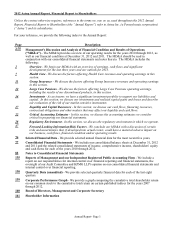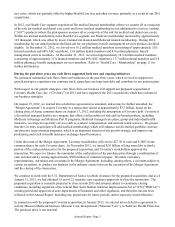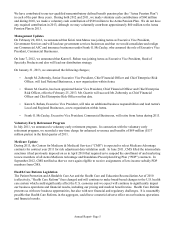Aetna 2012 Annual Report Download - page 12
Download and view the complete annual report
Please find page 12 of the 2012 Aetna annual report below. You can navigate through the pages in the report by either clicking on the pages listed below, or by using the keyword search tool below to find specific information within the annual report.Annual Report- Page 6
Key components of the legislation will continue to be phased in over the next several years, with the most
significant changes during that time due to occur in 2014, including health insurance exchanges (also known as
health insurance marketplaces) (“Insurance Exchanges”), Medicare minimum medical loss ratios (“MLRs”), the
individual coverage mandate, guaranteed issue, rating limits in the individual and small group markets, and new
industry-wide fees, assessments and taxes. We are dedicating and will continue to be required to dedicate material
resources and incur material expenses during that time to implement and comply with Health Care Reform as well
as state level health care reform. While the federal government has issued a number of regulations implementing
Health Care Reform, many significant parts of the legislation, including aspects of Insurance Exchanges, Medicaid
expansion, the scope of “essential health benefits”, employer penalties, assessments, fees and taxes, community
rating, reinsurance, risk transfer, risk adjustment and the implementation of Medicare minimum MLRs, require
further guidance and clarification at the federal level and/or in the form of regulations and actions by state
legislatures to implement the law. As a result, many of the impacts of Health Care Reform will not be known for
several years, and given the inherent difficulty of foreseeing how individuals and businesses will respond to the
choices afforded them by Health Care Reform, we cannot predict the full effect Health Care Reform will have on
us.
On June 28, 2012, the U.S. Supreme Court issued a decision that generally upheld the constitutionality of Health
Care Reform. However, federal budget negotiations, pending efforts in the U.S. Congress to amend or restrict
funding for various aspects of Health Care Reform and the possibility of additional litigation challenging aspects of
the law continue to create additional uncertainty about the ultimate impact of Health Care Reform.
The Supreme Court decision also permits states to opt out of the elements of Health Care Reform requiring
expansion of Medicaid coverage in January 2014 without losing their current federal Medicaid funding, and
governors in over a dozen states have indicated that they may not support Medicaid expansion. The ruling also
creates uncertainty regarding the effectiveness of Health Care Reform's “maintenance of effort” (“MOE”)
provision. If states are not subject to the MOE provision and allow certain programs to expire or choose to opt out
of Medicaid expansion, we could experience reduced Medicaid enrollment or reduced Medicaid enrollment growth.
We cannot predict whether pending or future federal or state legislation or court proceedings will change various
aspects of Health Care Reform or state level health care reform, nor can we predict the impact those changes will
have on our business operations or financial results, but the effects could be materially adverse.
For additional information on Health Care Reform, refer to “Regulatory Environment” beginning on page 28, and
for a discussion of certain factors that may cause our actual results to differ from currently anticipated results in
connection with Health Care Reform, refer to “Forward-Looking Information/Risk Factors” beginning on page 47.
Outlook for 2013
We expect to face continued external challenges in our business during 2013, including the adverse and uncertain
economic environment, the implementation of Health Care Reform and a continued low interest rate environment
for our investments. In 2013, we also expect an increase in Medicare as a percentage of our business and the
experience-rated nature of our large group insured business to result in lower operating margins. We are seeking to
offset these factors by pricing our products and services appropriately, managing our expenses, making strategic
investments designed to diversify our revenue streams and position us for the future and effectively managing our
capital. In mid-2013, we also expect to close on the proposed acquisition of Coventry.
Our primary business goals for 2013 are to drive profitable growth, including the successful integration of
Coventry, and to prepare Aetna for success in 2013 and beyond, particularly for the implementation of Insurance
Exchanges and guaranteed issue beginning in 2014.
Refer to “Forward-Looking Information/Risk Factors” beginning on page 47 for information regarding other
important factors that may cause our actual results to differ from those currently projected in “Outlook for 2013”
and/or otherwise materially affect us.
























